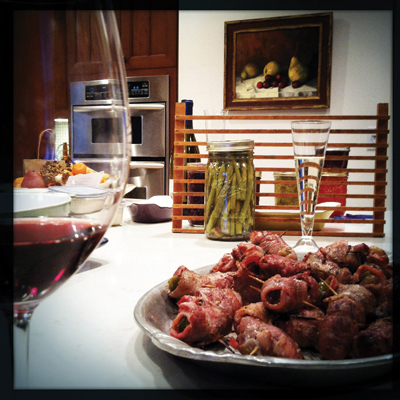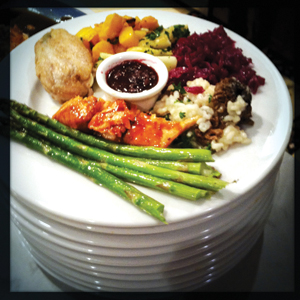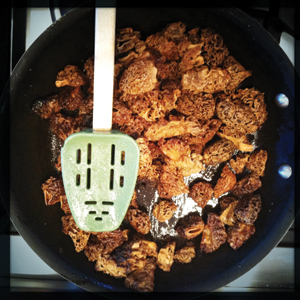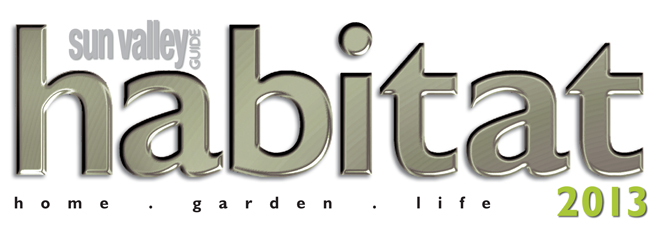
source it
fresh from the forest
Matt Furber sits down to a feast from Idaho's forests, streams and mountains, all foraged by his dinner companions.
photos by Stacie Brew
In an era when food can be express-shipped anywhere, it's refreshing to bring friends and families together to enjoy a mid-winter feast resplendent with sustenance gathered and hunted by those sitting around the dinner table.
The history of Idaho is steeped in the tradition of hunting and gathering. Not so long ago on the Camas Prairie, just west of Bellevue, the Shoshone and Bannock Indians gathered and feasted on the nutritious camas bulb. An annual festival still celebrates the tradition.
Today, Wood River families are rediscovering the benefits of gathering their food directly from the land, be it growing vegetables in the backyard, rummaging for mushrooms on the forest floor or stalking big game in the mountains surrounding their home.
Sarah Kolash, 31, has been preserving wild berries and canning vegetables from her mother's Broadford Road garden since she was a young girl. "My mom loves to can. It's very traditional—salsa, pickled green beans, asparagus, fruits, apricot jam, peaches. That's how I learned how to do it," Kolash said, when she dropped in on an assembly of fellow hunter-gatherers in Hailey's Fox Acres subdivision, the home of her friend and boss, Sally Boettger.
Sally, executive director of the Sun Valley Center for the Arts, is an upland game bird hunter. Her husband, Scott Boettger, is a staunch conservationist descended from a long line of hunters from the Valley Forge, Pennsylvania, area. The gathered cooks had decided on a meal of chukar, quail, squash, parsnips, cabbage and morel risotto all sourced by the hands around the table that night. The pièce de résistance was a taste of hatchery salmon—some of the first in 28 years to be caught near Stanley after making the round trip to the Pacific Ocean.
As Kolash sliced up some of her dill pickles, she explained that the red currant syrup she brought came from berries picked in August near her home in Gimlet by Boxcar Bend on the Big Wood River. "I have to say the tomatoes are my favorite. In the middle of winter to be able to open them—it's totally different from anything you can find in the grocery store. The tomatoes are the treat."
The beauty of a wild game dinner is that every course comes with a story the teller spins like a fishing reel with a roosterfish on the line. For the Boettgers, their tales revolve around the efforts of their English setters, who did the hard work of pointing out the quail that now lay on their plates.
 |
"We get it in its original packaging. That's how we're different from the Food Network. We know where our food comes from."
Scott Schnebly |
Groups that gather to share food they have harvested are proliferating, said Julie Fox-Jones, a neighbor whose family chicken farm preceded the Fox Acres subdivision that includes the Boettgers' home. The night before, she had helped prepare an Indian meal for a local Compassionate Young Leaders group. She made spicy eggplant with about a gallon and a half of the purple vegetable left over from her 2012 harvest. "We did a lot of hunting," Fox-Jones recalled of her youth growing up in the valley. "I used to have more animals. Now, I just do the chicken thing." She added that her son brings home fish from Alaska. For her, feasting from the land year-round means fewer trips to the grocery store. "I have all sorts of tricks for preservation that I picked up from people here and there." She is determined to embrace the ethic of sustainable self-sufficiency that she learned from her parents, who only had to purchase specialty imports like coffee, baking powder and other staples. Nonetheless, she was already out of carrots by this mid-February night.
It's clear that for many hunters and gatherers, preserving the bounty of summer by one's own hand brings some balance to the quest for a sustainable, healthy food web. "There's a resurgence and I appreciate it," Kolash said. As Sally Boettger and her daughter Emily, a Community School fifth-grader, began to sauté their handpicked morel mushrooms for the planned risotto, she added that "it used to be for the sake of the environment—now it's for the sake of your health."
A fist-sized morel decorated the Boettger kitchen counter as more guests gathered with their wares to help prepare the meal. When asked where she found such an impressive quantity of mushrooms, Emily Boettger said jokingly, "Whisky Canyon." Scott added that some of the good spots are along the Big Wood River on property that is being protected with help from the Wood River Land Trust, the organization he leads. A gorgeous orange squash that complemented the assembled game was harvested from Fred and Judy Brossy's Shoshone farm, where they run Ernie's Organics. The farm is a prize of the Land Trust's ongoing effort to protect productive land and habitat in south-central Idaho.
"It all fits together," Scott said, as he and Emily showed the contents of their deep freezer—deer, elk and pronghorn, meat that had been through the family vacuum-packing assembly line. "The connection to the land is direct." Scott's bounty comes from his annual Sportsman's Package hunting and fishing license, which includes the right to harvest steelhead, salmon, elk, deer and bear with archery and muzzleloader permits. When he shoots an animal, he takes on all the work, from field dressing to setting the table. "If you're going to take something out of the wild, you should treat it well, right?" he said. Outside the garage, at a neighbor's house, a rooster was crowing.
Scott Schnebly arrived at the Boettger house with duck rumaki (bacon-wrapped duck with jalapeño and watercress) that was quickly grilled up as an appetizer while Schnebly prepared the chukar and quail just defrosted from one of the many freezers that he stocks each year with his partner, Susanne Connor. Together the couple run Lost River Outfitters in Ketchum. "You won't find anything like this in New York City," Schnebly said, while stuffing and breading the chukar for the frying pan and talking about the fishery potential downstream from Magic Reservoir. "We get it in its original packaging. That's how we're different from the Food Network. We know where our food comes from."
"If you're going to take something out of the wild, you should treat it well, right?"
Scott Boettger |
"It's what we do," said Connor, who manages a number of gardens at the couple's Hailey home on the Big Wood River. "We have lots of jam and pickled food." Connor prepared rotkohl, cabbage with vinegar—a specialty of Bavaria, Connor's homeland. "It's what you eat with the game meats." Connor, who also makes a game sauce with elderberries, cranberries, blueberries, blackberries and boysenberries, said she likes to hunt game because "it's not pumped up with hormones." She prefers to track large game. "Birds are on the top of the world," she said, explaining that in addition to putting food on the table, her aim is to minimize the number of animals she kills. A single bird doesn't provide much food. "I hunt deer and elk—the bigger, the better—one bullet."
Despite the challenges to survival of creatures like the threatened sage grouse due to loss of habitat and other impacts, Scott is convinced that the stewardship of species is closely tied to knowledge gleaned from hunters who have an interest in sustaining the animals they hunt. Passing the torch is a piece of the puzzle. Emily has her own rifle. Sally has a Remington shotgun. Scott's son Gunner, a third-grader, prefers to fish. He tells the story of bait fishing for king salmon and almost being pulled into the river. "They are so strong," he said, demonstrating his technique by planting a foot on the living room floor with his hands wielding an invisible fishing rod. "Dad pulled on my back."
After all the preparations for the meal were complete, it was time to eat the precious cache of plump morels in the risotto, which went exceedingly well with the chukar, quail, rotkohl, asparagus, the beautiful orange squash and a tart that Connor made with apricots and currants plucked from the rocks and desert sage around Magic Reservoir. |
Idaho's other gem
Idaho's grasses, forbs and shrubs aren't terribly appetizing for most palates, but the state's wild botanical bounty does supply nutritious forage for the animal kingdom. Hunters are grateful for the diversity of game sustained by the high desert and forest ecology of the south-central Idaho mountains.
Human foragers, however, are not entirely relegated to the multitude of berries for a wild treat, as there is one succulent morsel in the woods and along the rivers in particular that holds great cachet with those who like to hunt for wild food.
It is the morel mushroom.
Just the thought of looking for them in post forest-fire understory, where greedy hoards of morel fanatics often flock in search of their bounty, is enough to make one salivate. The fungus is intensely delicious when sautéed and can grow as big as a brain, which the morel distinctly resembles at that size.
Finding morels is more art than science. Connoisseurs prefer smaller, harder-to-find specimens for the ultimate taste. These can be covered in leaves, soil and ash, and nearly impossible to see in their camouflage. But once the forager spots a pattern in the duff, like a multi-dimensional puzzle, the morel's continued growth is certain to be curtailed. There is a limit to the take for the casual hunter, however. The quantity is five gallons.
Morels grow in a few varieties (Blaine County mushroom hunters know them locally as blonde morels), and can be confused with verpa mushrooms that cause severe dysentery. But that species is not common to the area.
What is needed to collect morels? A stick, a bag and a keen eye open to seeing the ground in a different light should do the trick. A little insider information about where to search also helps. So be kind to your neighbor; she might point you in the direction to learn about more edible wild plants like the plethora described in books by John Kallas (www.wildfoodadventures.com), who travels the country teaching how to forage successfully.

|



